How to Use an Embroidery Machine for Quilting in 2025
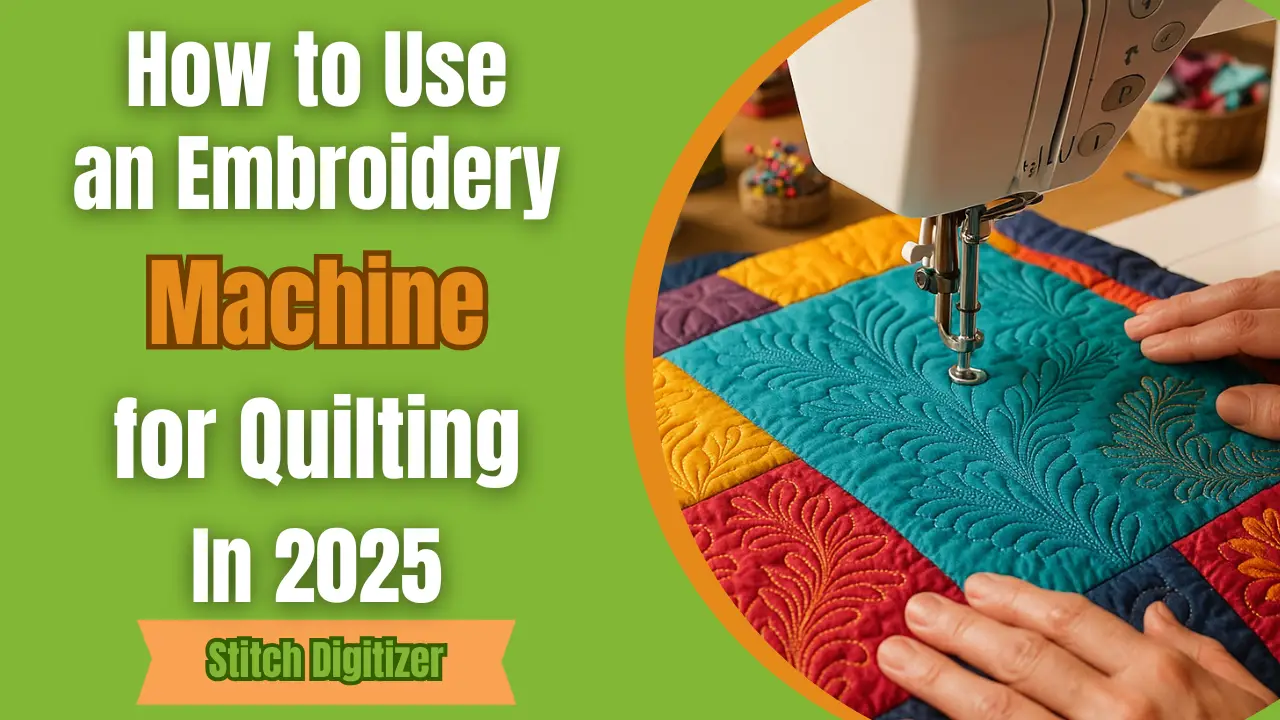
Embroidery machine for quilting is fun, creative, and easier than you think. This beginner-friendly guide will walk you through everything. You’ll learn what tools to use, follow simple steps, and pick up smart tips along the way. Ready to turn your embroidery machine into a quilting powerhouse? Let’s get started!
Introduction of Using an Embroidery Machine for Quilting
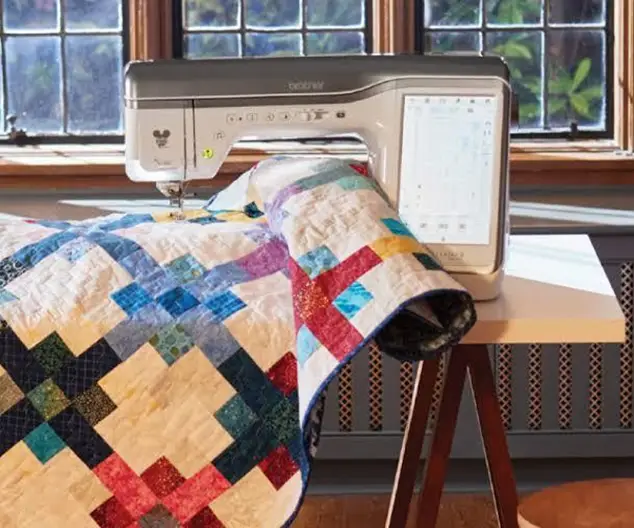
Embroidery machines are a fantastic tool for quilters who want to enhance their projects with intricate patterns and designs. These machines, typically used for adding detailed stitches to fabric, can do much more. You can use them for quilting too! Their precision and versatility help you save time and place each stitch perfectly.
Understanding Quilting with an Embroidery Machine
Quilting with an embroidery machine involves stitching layers of fabric (the quilt top, batting, and backing) together using automated embroidery designs. Instead of manually stitching quilt lines or motifs, your embroidery machine handles the intricate work for you, with beautiful precision.
Traditional Quilting VS Embroidery Machine Quilting
Traditional quilting uses a sewing machine or hand stitching. With an embroidery machine, you can create detailed patterns, textures, and custom designs without much effort. It’s perfect for modern quilters who love creativity and efficiency. If you want to get knowledge about the best embroidery machine for a home business, then you can visit: machine for home business
Advantages of Using an Embroidery Machine for Quilting
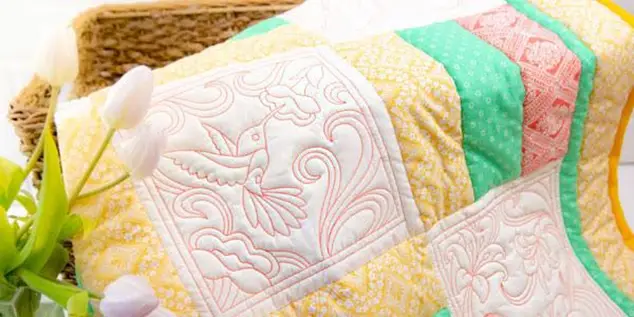
Quilting with an embroidery machine offers the following benefits to users:
1. Precision
One big benefit of using an embroidery machine is its accuracy. Hand quilting can make stitches uneven, but a machine keeps them the same. This helps a lot with detailed designs and soft fabrics. It makes your quilt look neat and professional.
2. Creative Freedom
With an embroidery machine, the world of design opens up. Quilters can experiment with a wide range of stitches, patterns, and motifs that would be difficult or impossible to replicate by hand. whatever the shape or design, an embroidery machine gives you the creative freedom to explore new ideas and push the boundaries of traditional quilting.
3. Time saving
Embroidery machines save a significant amount of time by automating the stitching process. The machine finishes in hours what takes days by hand. You save time, make more quilts, or focus on other creative work.
4. Easy for beginners
Even if you’re new to quilting, an embroidery machine can help you achieve professional-quality results without a steep learning curve.
Essential Tools and Materials for Quilting
Before you dive into the magical world of embroidery machine for quilting, it’s essential to get your toolkit right. Whether you’re just starting or looking to level up your craft, this guide covers what you need to quilt like a pro. The first and foremost tool you need is a good embroidery machine.
Features to Look for in Your Embroidery Machine for Quilting
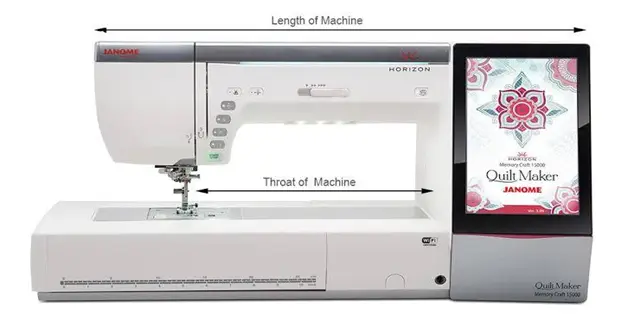
- Pick a machine that’s strong and smart, not just good-looking.
- Choose one with a large hoop size to reduce re-hooping and keep designs flowing smoothly.
- Make sure it has built-in quilting patterns or lets you import custom ones through USB.
- Look for adjustable presser foot height and stitch tension to avoid puckering and skipped stitches.
- A powerful motor and easy-to-use controls make quilting faster and more enjoyable.
Other Supplies You Will Need
You don’t just need the machine itself, you need the right tools to match.
Quilting threads:
Start with strong, smooth quilting threads that glide through fabric without breaking. Cotton or polyester threads both work well, depending on the texture and finish you want for your quilt. A complete guide on why your embroidery machine keeps breaking thread
Batting fabric:
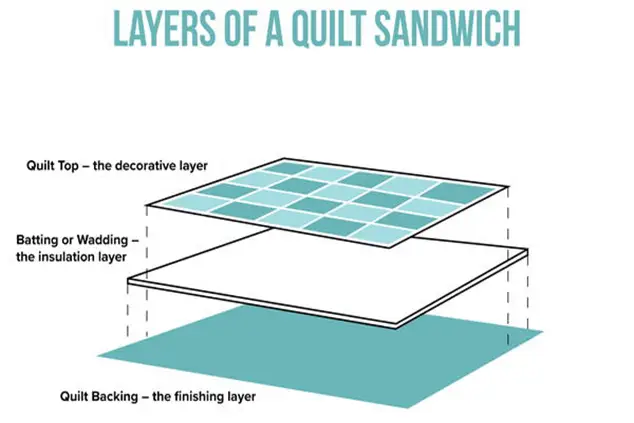
You will also need batting and backing fabric to form the classic quilt sandwich. Batting gives your quilt that soft, cozy feel. While the backing holds it all together and shows off your stitches from the other side. Make sure these materials complement your top fabric in weight and texture for a balanced finish.
Quilting needles:
Don’t forget to stock up on quilting needles. These are specially designed to punch through multiple layers without bending or snapping.
Stabilizer:
Stabilizers help keep your fabric firm and flat while stitching. They prevent shifting, warping, and bunching. With the right tools and machine features in your corner, you’re not just quilting, you’re creating fabric magic. A complete guide on embroidery stabilizers
Preparing Your Embroidery Machine for Quilting
Proper setup ensures flawless stitching. Before you start your quilting journey:
Clean and Maintain the Machine:
Dust, lint, and old threads can cause skipped stitches and thread breaks. Clean your embroidery machine thoroughly. Oil any parts as recommended by your machine’s manual. Replace the needle to avoid bending or snapping during stitching. For more about cleaning your embroidery machine then you can visit: Cleaning your Embroidery Machine: A Complete Guide
Attach the Correct Presser Foot:
A free-motion quilting foot or an open-toe embroidery foot provides the visibility and flexibility you need when quilting.
Adjust the Tension Settings:
Different fabrics and batting thicknesses affect how your machine stitches. Always do a test stitch on scrap fabric. If you want to learn how to fix tension issues, then you can visit: Troubleshooting Tension Issues
Adjust the Upper Tension Dial:
Until the stitches look balanced on both sides.
Properly Hoop the Quilt Layers:
Creating a quilt sandwich (top fabric, batting, and backing) is crucial. Lay the layers flat with no wrinkles. Hoop them tightly but without stretching the fabric.
Add stabilizer:
If needed for extra support.
Choosing and Customizing Quilting Designs:
One of the most exciting parts of quilting with embroidery machines is picking or designing your patterns. Following are some types of designs:
● Built-In Designs
Many machines offer classic quilting designs are great for beginners like Stippling, Feathers, Spirals and Geometric
● Custom Patterns
If you want a unique design, buy quilting files online or make your own using software like Hatch, Embrilliance, or Brother PE-Design.
- Use paper templates or software preview tools to map out your quilt.
- Mark your fabric lightly to align the design perfectly.
- Always test-stitch new designs on a sample sandwich before working on your actual quilt.
Step-by-Step Quilting with an Embroidery Machine
Here’s how you can start quilting with embroidery machine step by step:
Step 1: Gather Your Materials
First, get all of these essential items to start quilting your first project.

- Quilt top fabric Batting (middle soft layer)
- Backing fabric
- Quilting thread
- Quilting needles.
- Stabilizer (optional but helpful)
- Embroidery machine with hoop
Step 2: Prepare the Quilt Layers
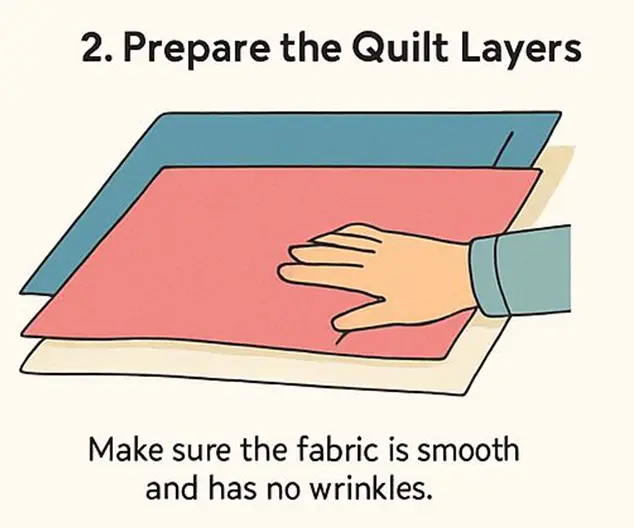
- Lay the quilt top, batting, and backing on a flat surface.
- Make sure the fabric is smooth and has no wrinkles.
- Pin or baste all three layers together so they don’t move during stitching.
Step 3: Set Up Your Machine
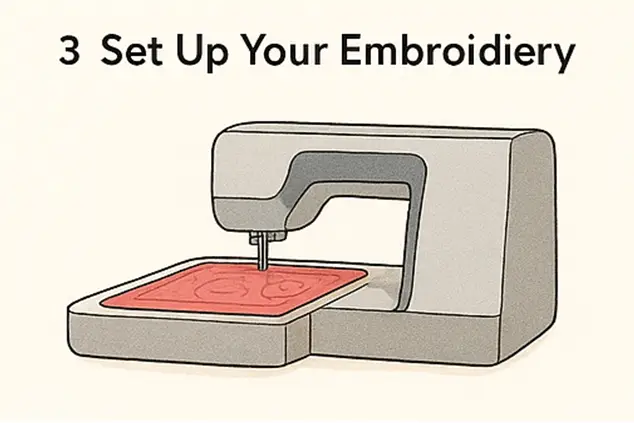
- Plug in your embroidery machine and turn it on.
- Choose a hoop that fits your design size.
- Thread the machine with quilting thread.
- Pick a built-in design or upload a new one using a USB.
Step 4: Hoop the Quilt
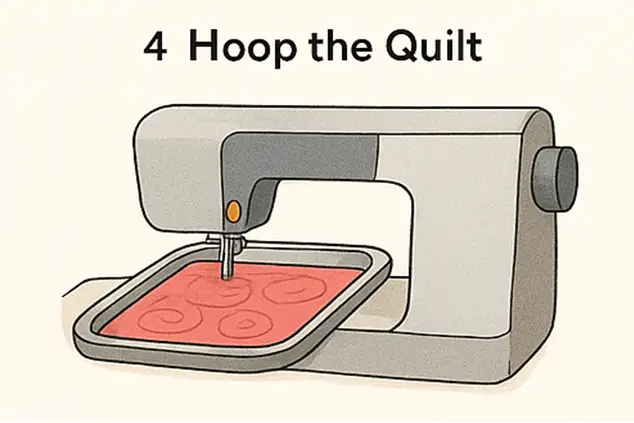
- Place the quilt layers in the hoop.
- Make sure the fabric is flat and the design is centered.
- Tighten the hoop, but not too much. The fabric should be secure but not stretched tight.
Step 5: Start Quilting
- Press start and let the machine begin stitching.
- Watch the process and make sure the thread doesn’t break.
- If you’re quilting a big area, move the hoop and re-hoop when needed.
Step 6: Manage Large Quilts
- Roll the sides of the quilt and clip them with hair clips or fabric clamps.
- Support the quilt using a table or chair so it doesn’t pull on the needle.
- Take small breaks and check if everything is stitching correctly.
Step 7: Finish the Design
When the design is complete, stop the machine.
- Remove the hoop carefully.
- Cut any extra threads using small scissors.
Step 8: Add the Binding
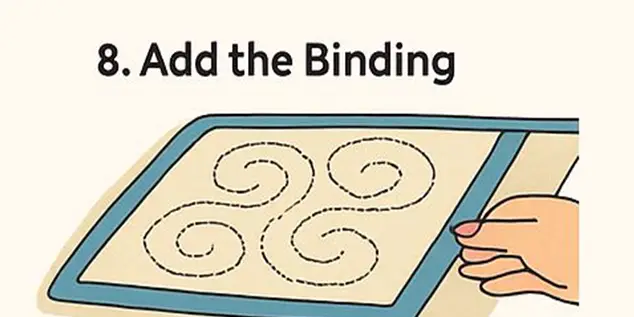
- Cut fabric strips for the edges of the quilt.
- Sew the strips on all sides to give a clean finish.
- You can do this by hand or use your sewing machine.
Some handy tips:
- Always test your design on a scrap piece first.
- Use high-quality thread to avoid breakage.
- Make sure the needle is sharp and not old.
Troubleshooting Common Issues in Embroidery Machine Quilting
Even the most experienced quilters run into a few hiccups now. If your embroidery machine starts acting a little rebellious mid-project, don’t panic.
Most quilting problems stem from small oversights that are easy to fix with the right know-how. By understanding the causes behind these common issues and their solutions you’ll be able to keep your project on track.
Uneven or Skipped Stitches
One of the most frustrating issues in machine quilting is when stitches appear uneven or skip altogether. This usually happens when the needle isn’t sharp enough or isn’t suited for quilting layers. A worn-out or incorrect needle struggles to penetrate thick fabrics, causing the thread to miss its loop and skip the stitch.
Solution:
To fix this, always start each quilting project with a fresh, high-quality quilting needle. Make sure you’re using a needle size that matches your thread weight and fabric thickness. Also, double-check that the needle is inserted properly and fully secured in the machine. A loose needle can cause chaos even if it looks fine at first glance.
Thread Breakage During Stitching
If your thread keeps breaking during a design, it can ruin your workflow. This usually happens because of tight tension, a damaged needle, or low-quality thread.
Solution:
Lower the upper thread tension a little. Change the needle if it’s old or rough. Use strong, good-quality thread made for embroidery or quilting. Check the thread path, one small mistake in threading can cause breaks.
Puckering or Wrinkling Fabric
Puckered or wrinkled quilt fabric is another common challenge, especially when quilting dense patterns on light materials. This usually happens when the layers aren’t hooped tightly or the stabilizer isn’t doing its job correctly.
Solution:
To avoid this, always make sure your quilt sandwich is flat, smooth, and hooped with even tension. The stabilizer should match your fabric weight. It must offer enough support to prevent shifting. Using a light adhesive spray to hold layers together, reducing movement during stitching.
Misaligned or Crooked Designs
When your beautifully planned quilting design ends up off-center or slightly tilted. It can be incredibly disappointing. This issue often stems from poor hoop alignment or incorrect placement settings in your embroidery software.
Solution:
To fix this, take your time when hooping and double-check that your fabric is straight and centered. Use built-in alignment tools or templates to position your design accurately.
Fabric Not Moving Smoothly
If your fabric feels stuck, check the presser foot settings or the hoop tightness. A hoop that’s too tight or too much pressure can stop the fabric from moving smoothly. The fabric needs a little freedom to glide.
Solution:
To correct this, confirm that the presser foot pressure is set appropriately for your quilt fabric. You want a firm grip that holds the fabric steady without turning it into a trampoline.
Bobbin Thread Showing on Top
Nothing ruins the look of a beautiful quilt faster than bobbin thread peeking through where it shouldn’t. This typically happens when your top thread tension is too tight. It causes pulling the bobbin thread up through the fabric.
Solution:
The solution is simple. Lower your top thread tension slightly and test on a fabric scrap. If the issue persists, clean your bobbin case and re-thread both top and bobbin threads carefully. Consistent, balanced tension is the secret to perfect, clean quilting lines. If you want a complete guide on this issue then you can visit: Embroidery Machine Bobbin Thread
Tips for successful quilting with embroidery machine
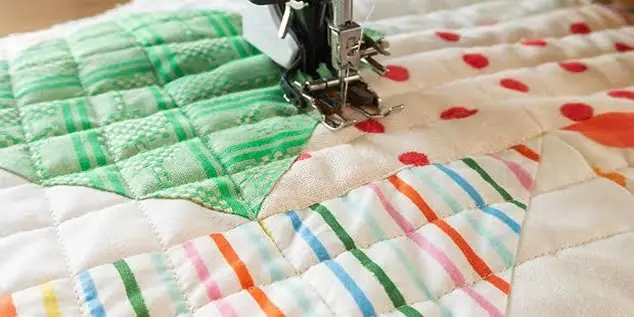
Before you start quilting, use this simple checklist to make sure everything’s ready for a smooth and successful project:
Fabric Preparation
Pre-wash and iron fabrics to prevent shrinking and wrinkles. Cut fabrics to the correct size for your quilt top, batting, and backing. Check fabric for any defects or tears.
Embroidery Machine Setup
Clean the machine, including the bobbin case and needle area. Check the machine’s threading and ensure the correct needle is inserted. Confirm the hoop size is appropriate for your quilt design. Test the machine with scrap fabric to check for proper stitch quality.
Stabilizers and Backing
Choose the right stabilizer for your fabric (cutaway or tearaway, depending on the fabric). Attach the stabilizer securely to the quilt layers. Baste or pin the quilt layers together to prevent shifting during stitching.
Design Selection and Setup
Choose the embroidery design for your quilt and load them onto the machine. Center the design on the quilt top to ensure proper placement. Adjust machine settings for stitch type, tension, and speed as needed.
Threading and Tension
Use high-quality embroidery thread for a smooth finish. Double-check the thread tension (top and bobbin) for balance. Make sure the thread is correctly loaded on both the top and bobbin spools.
Conclusion
Embroidery machine for quilting is fun, fast, and full of creative possibilities. You don’t need to be an expert to get started just take it one step at a time. Play with patterns, try new threads, and enjoy the process. The more you explore, the more confident you’ll become. We hope this blog will help you and turn every quilt into something truly your own. Keep creating and enjoy every stitch!
FAQs
Can all embroidery machines be used for quilting?
Not all embroidery machines are quilting champs. To quilt smoothly, you need one with a large hoop, adjustable tension, and a sturdy motor. If your machine lacks these features, quilting may become more of a struggle than a joy. Choose wisely and let your creativity flow.
What stabilizer works best for quilting?
Go for a lightweight tear-away or cut-away stabilizer. It should support your fabric during stitching without making your quilt stiff. The key is balance, firm enough to stabilize, soft enough to cuddle.
How do I manage thick quilts on an embroidery machine?
Thick quilts can be tricky, but you can totally handle them. Roll the extra fabric, and use clamps to keep things steady. Take it slow and let the machine glide through the layers.
What thread works best for machine quilting?
Use high-quality cotton or polyester thread made for quilting or embroidery. These threads glide smoothly and can handle dense stitching without breaking.
How do I line up embroidery designs on a quilt?
Use your machine’s built-in alignment tools or grid templates. Mark your fabric lightly with chalk or a water-soluble pen. Take your time to center the design before stitching.
Which brand offers the best quilting embroidery machines?
Bernina, janome, Brother, Singer are the best brands to consider while buying good quilting embroidery machines. Out of these brands, Brother SE700, Janome MC6650, Brother XR9550, and Singer quantum stylis

